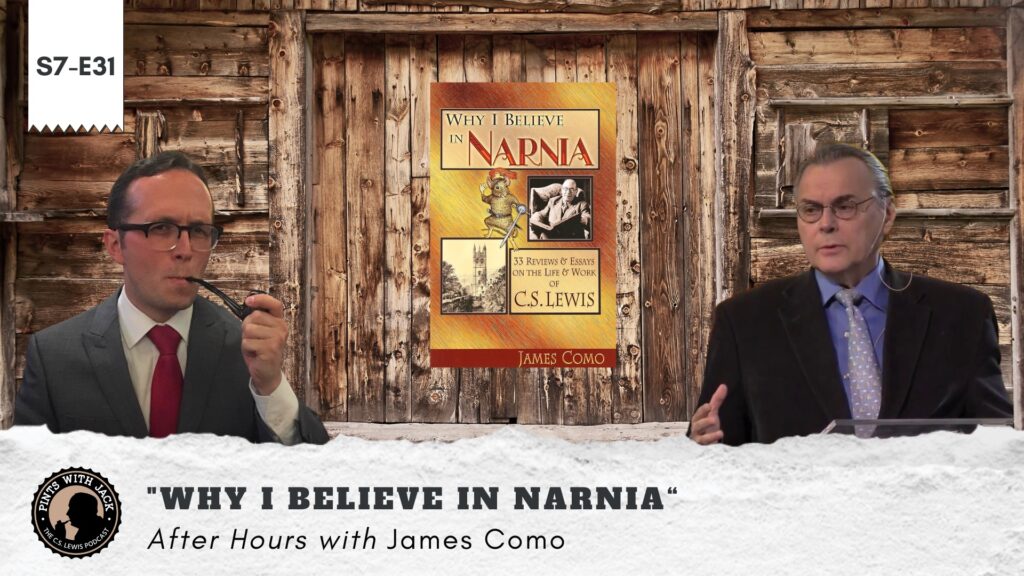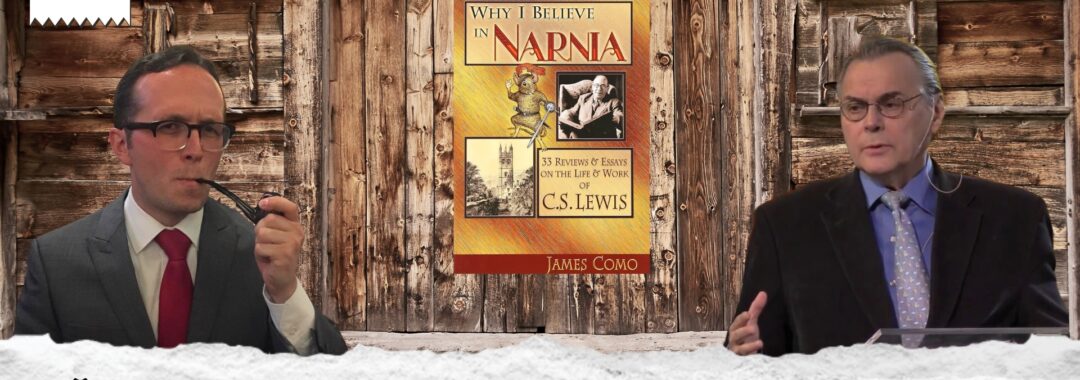
To wrap up Narnia Month, David interviews Dr. James Como about his book “Why I Believe in Narnia”, a collection of essays and reviews about C. S. Lewis and his works.
S7E31 – AH – “Why I Believe in Narnia”, After Hours with James Como (Download)
If you enjoy this episode, please subscribe on your preferred podcast platform, such as iTunes, Google Podcasts, Spotify, Audible, and many others…
For information about our schedule for Season 7, please see the our season roadmap, containing a list of all the episodes we plan to record together, as well as “After Hours” interviews with special guests.
Finally, if you’d like to support us and get fantastic gifts such as access to our Pints With Jack Slack channel and branded pint glasses, please join us on Patreon for as little as $2 a month.
Show Notes
Introduction
Quote-of-the-week
All the things that have ever deeply possessed your soul have been but hints of it—tantalising glimpses, promises never quite fulfilled, echoes that died away just as they caught your ear. But if it should really become manifest—if there ever came an echo that did not die away but swelled into the sound itself—you would know it. Beyond all possibility of doubt you would say “Here at last is the thing I was made for”.
C. S. Lewis, The Problem of Pain
Biographical Information
Professor James Como holds a Ph.D. in Language, Literature and Rhetoric from Columbia University and now is Professor Emeritus of Rhetoric and Public Communication at York College (CUNY). He was a founding member of the New York C. S. Lewis Society in 1969, the oldest C. S. Lewis society in the United States.
He has written five books about C.S. Lewis which include: “C. S. Lewis: A Very Short Introduction” (or VSI for short), “Remembering C.S. Lewis”, “Branches to Heaven”, “Mystical Perelandra”, and the book which we’ll be discussing today, “Why I Believe in Narnia”.
These books, along with his many journal articles on Lewis and on-air commentary for five biographical documentaries have established Professor Como as one of the most highly-regarded Lewis scholars in the world and we’re honoured to welcome him here today.
Biographical Information
Chit-Chat
–
Toast
- David was drinking a Best Day Brewing Kolsch.
- Dr. Como had Irish Cream.
Discussion
01. “Background”
Q. You’ve been a guest on the show a few times, but for those who don’t know you, could you introduce yourself and explain your connection with C. S. Lewis?
- Dr. Como first encountered Lewis in an undergraduate course, where he read “An Experiment in Criticism”. He describes another encounter with him in National Review, from an article titled “Rebirth of Christ”. This provoked him to start the New York C. S. Lewis Society so he could discuss Lewis’ works. The organisation has been influential in the creation of other societies.
02. “Structure”
Q. Could you tell us about the background and structure of the book?
- The book was published in 1998, not 1988.
- The first part of the book is a review section for C. S. Lewis’ works, private correspondence, and media created about him. He discusses “Till We Have Faces” and “Perelandra”.
- In part two, which discusses the works in greater detail, Dr. Como argues that readers should see Lewis as a public philosopher rather than just an evangelist. This can be seen in “The Abolition of Man” and “That Hideous Strength”, but also in his shorter essays.
- In the final section, Dr. Como gets more personal, writing personal essays about his time at Oxford, toasts to Lewis’ companions, and Lewis’ book reviews.
- While writing his masters thesis, Como got sick, and spent his time resting and reading Narnia, beginning with “The Lion, the Witch, and the Wardrobe”.
- zDr. Como gave a plug for “The Christian Mind of C. S. Lewis: Essays in Honor of Michael Travers” by Andrew J. Spencer.
03. “Bringing it all together”
Q. You’re writing articles for lots of different organisations. What prompted you to collect them all and publish them as a single volume?
- Dr. Como discussed an essay that related to Dr. Armand Nicholi, whose teachings on C. S. Lewis and Sigmund Freud eventually became a book and documentary called The Question of God, which has turned into a play and movie, Freud’s Last Session:
04. “Part I: Reviews”
Q. Let’s try to do a sampling of each of the sections. Could you pick an essay from of the reviews?
- The seventh essay in this section was on Nicholi’s book “The Question of God”, where Freud was described as “faithless” and Lewis “reasonable”.
- Dr. Como recalled an off-Broadway play called Freud’s Last Session, a fictional back-and-forth between Lewis and Freud regarding atheism and Christianity. It has since been made into a movie.
- Another essay reviews “The Collected Letters of C. S. Lewis”, essentially crafting a biography of Lewis. David appreciated this section, because Season 7 is largely dedicated to Lewis’ letters; “Letters to an American Lady”, “Letters to Children”, and “Latin Letters”.
- David recently picked up “Yours, Jack: Spiritual Direction from C. S. Lewis” by Paul Ford, the abridged version of the collected letters.
05. “Part II: Critical Views”
Q. Let’s move on to the second section: Critical Reviews. Are there any essays that you’d like to talk about?
- Dr. Como discussed the Wake Forest Baptist Seminary lectures that he gave, and noted Lewis’ warning against cultural idolatry.
- The other essay he mentioned was “Lewis the Book Reviewer”. One review that Lewis gave was on a book written about Aristotle’s “Poetics”, a book that changed Dr. Como’s life in a pivotal way.
06. “Part III: Personal Essays”
Q. The last section is your personal essays. Can you choose a few to discuss?
–
07. “Why I Believe in Narnia”
Q. Since this is Narnia Month, let’s zoom in on the Narnia-specific article in your book. Simply put, why do you believe in Narnia?
- One of the cited books in the essay was Lewis’ “An Experiment in Criticism”, where Dr. Como is discussing his literary belief in Narnia.
- In Narnia, hope is approached through many angles, including skepticism, as seen in “The Silver Chair”, when the witch is winning over the minds of the children, until Puddleglum burns his foot. A similar event happens in “Perelandra”, with Ransom losing a debate, until he punches him in the face, and also in “Till We Have Faces”, where Orual is killed off by Lewis as she continues to spiral.
- In the essay, Dr. Como quotes “The Wind in the Willows”, which has a very intriguing scene with the god Pan.
- In “The Problem of Pain” and “Miracles”, Lewis ends with a scene that “transports you”.
- David has started appropriating Lewis’ feeling on wonder from “Surprised by Joy” after reading the book “Phantastes” by George MacDonald, only he applies it to Lewis himself…
I saw the bright shadow coming out of the book into the real world and resting there, transforming all common things and yet itself unchanged. Or, more accurately, I saw the common things drawn into the bright shadow.
C. S. Lewis, Surprised by Joy
08. “Mystical Lewis”
Q. Next season, we will be returning to the Ransom Trilogy, specifically Perelandra. You have written on this book in “Mystical Perelandra”. Can you make a pitch to the listeners as to why they should read this book?
- Dr. Como described the trilogy as a mystical experience rather than a science fiction series.
“It is not for nothing that you are named Ransom,” said the Voice…
C. S. Lewis, Perelandra
One must have Faith… It snapped like a violin string. Not one rag of all this evasion was left. Relentlessly, unmistakably, [Maleldil] pressed down upon him the knowledge that this picture of the situation was utterly false. His journey to Perelandra was not a moral exercise, nor a sham fight.
C. S. Lewis, Perelandra
- David decided to get Dr. David Downing on next season to discuss his book “Into the Region of Awe: Mysticism in C. S. Lewis”.
- Dr. Como applied a Lewis quote to the author himself…
His work is one, like a growing thing, a tree…with branches reaching to heaven and roots to hell…And between these two extremes comes all the multiplicity of human life…To read him is to grow in mental health.
C. S. Lewis, The Allegory of Love, Referencing Edmund Spenser
Wrap-Up
Concluding Thoughts
- Dr. Como discussed another short book of his called “From Parlor to Public Square: A Very Brief Course on Our Many Conversations”, which talks about communication theory.
